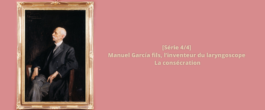


27 september 2023
By highlighting the story of Manuel García fils (1805-1906), the Centre Européen de Musique is paying tribute to a polymath, teacher, singer, scientist and researcher, a member of a unique family saga: the García dynasty. The invention of the laryngoscope by Manuel García Jr. in 1854 was no accident, and the acquisition by the Centre Européen de Musique of this priceless relic is a powerful symbol that fully embodies the missions the CEM has set itself in the 21st century: building bridges between the present and the past; uniting the arts, sciences and humanities. After a third episode devoted to the scientist Manuel García fils, discover the latest in our historical series, written by Thomas Cousin, a doctoral student in history and musicology at the Université Libre de Bruxelles/Sorbonne University.

On 17 March 1905, St Patrick's Day, Manuel García entered the second century of his immortality. His centenary celebrations were a model of their kind, consecrating the international renown of the inventor of the laryngoscope. Invited to Buckingham Palace, Manuel García was decorated by King Edward VII of England with the insignia of Commander of the Royal Victorian Order. Also received with great pomp by the Royal Medical and Chirurgical Society in Hanover Square, the maestro was awarded the Grand Gold Medal of Science by the German laryngologist Dr. Fränkel on behalf of Emperor Wilhelm II, in recognition of the merits of "the man whose genius has illuminated the hitherto obscure areas of the larynx and the source of the living human voice, thus laying the foundations of the physiology of the voice". Finally, the Marquis of Villalobar, emissary of the King of Spain Alfonso XIII, invested "Don Manuel García" with the Royal Order of Alfonso XII "as a high reward for your merits and the services rendered to humanity by your science and your labour".
Among the endless tributes from the world of music, we will remember Blanche Marchesi's formula for the "Christopher Columbus of the Larynx". The great discovery of this explorer and theorist of the vocal tract opened up immense horizons for science, bringing within its reach many diseases that had previously remained incurable. The invention of the laryngoscope made medical treatment possible and saved countless lives. It is not surprising that among the many societies and associations represented at Hanover Square to celebrate "the father of the laryngoscope" are laryngology societies from the United States, Germany, England, France, Italy, the Netherlands, Spain, Austria, Hungary and Russia. Telegrams received from universities and laryngological societies in Stockholm, Moscow and Krakow, Japan, Montreal and Brooklyn attest to the worldwide scope of these commemorations. A congratulatory telegram from the British Prime Minister, Arthur Balfour, joined the festivities, while tributes from the Royal Society of London, the Royal Academy of Music and the Royal College of Music followed. The presentation of the portrait of Manuel García painted by the American John. S. Sargent, financed by international contributions from friends and admirers of the centenary.
By virtue of his exceptional longevity, Manuel García Jr was able to magnify the monumental musical legacy bequeathed by his father, while creating his own pedagogical style and singing method based on cutting-edge knowledge for the time. Like his sisters Maria Malibran and Pauline Viardot, Manuel García left his mark on the history of nineteenth-century opera, and opened up new horizons for medicine and science. Passed down from generation to generation in the García family, the original 1854 laryngoscope is one of the treasures of the Memorabilia García. Friends of the arts, sciences and humanities can rejoice in the acquisition and conservation by the Centre Européen de Musique of this priceless collection, a veritable jewel in Europe's cultural heritage.
By Thomas Cousin
Doctoral student in history and musicology
Free University of Brussels/Sorbonne University
27 september 2023
By highlighting the story of Manuel García fils (1805-1906), the Centre Européen de Musique is paying tribute to a polymath, teacher, singer, scientist and researcher, a member of a unique family saga: the García dynasty. The invention of the laryngoscope by Manuel García Jr. in 1854 was no accident, and the acquisition by the Centre Européen de Musique of this priceless relic is a powerful symbol that fully embodies the missions the CEM has set itself in the 21st century: building bridges between the present and the past; uniting the arts, sciences and humanities. After a third episode devoted to the scientist Manuel García fils, discover the latest in our historical series, written by Thomas Cousin, a doctoral student in history and musicology at the Université Libre de Bruxelles/Sorbonne University.

On 17 March 1905, St Patrick's Day, Manuel García entered the second century of his immortality. His centenary celebrations were a model of their kind, consecrating the international renown of the inventor of the laryngoscope. Invited to Buckingham Palace, Manuel García was decorated by King Edward VII of England with the insignia of Commander of the Royal Victorian Order. Also received with great pomp by the Royal Medical and Chirurgical Society in Hanover Square, the maestro was awarded the Grand Gold Medal of Science by the German laryngologist Dr. Fränkel on behalf of Emperor Wilhelm II, in recognition of the merits of "the man whose genius has illuminated the hitherto obscure areas of the larynx and the source of the living human voice, thus laying the foundations of the physiology of the voice". Finally, the Marquis of Villalobar, emissary of the King of Spain Alfonso XIII, invested "Don Manuel García" with the Royal Order of Alfonso XII "as a high reward for your merits and the services rendered to humanity by your science and your labour".
Among the endless tributes from the world of music, we will remember Blanche Marchesi's formula for the "Christopher Columbus of the Larynx". The great discovery of this explorer and theorist of the vocal tract opened up immense horizons for science, bringing within its reach many diseases that had previously remained incurable. The invention of the laryngoscope made medical treatment possible and saved countless lives. It is not surprising that among the many societies and associations represented at Hanover Square to celebrate "the father of the laryngoscope" are laryngology societies from the United States, Germany, England, France, Italy, the Netherlands, Spain, Austria, Hungary and Russia. Telegrams received from universities and laryngological societies in Stockholm, Moscow and Krakow, Japan, Montreal and Brooklyn attest to the worldwide scope of these commemorations. A congratulatory telegram from the British Prime Minister, Arthur Balfour, joined the festivities, while tributes from the Royal Society of London, the Royal Academy of Music and the Royal College of Music followed. The presentation of the portrait of Manuel García painted by the American John. S. Sargent, financed by international contributions from friends and admirers of the centenary.
By virtue of his exceptional longevity, Manuel García Jr was able to magnify the monumental musical legacy bequeathed by his father, while creating his own pedagogical style and singing method based on cutting-edge knowledge for the time. Like his sisters Maria Malibran and Pauline Viardot, Manuel García left his mark on the history of nineteenth-century opera, and opened up new horizons for medicine and science. Passed down from generation to generation in the García family, the original 1854 laryngoscope is one of the treasures of the Memorabilia García. Friends of the arts, sciences and humanities can rejoice in the acquisition and conservation by the Centre Européen de Musique of this priceless collection, a veritable jewel in Europe's cultural heritage.
By Thomas Cousin
Doctoral student in history and musicology
Free University of Brussels/Sorbonne University


Playlist